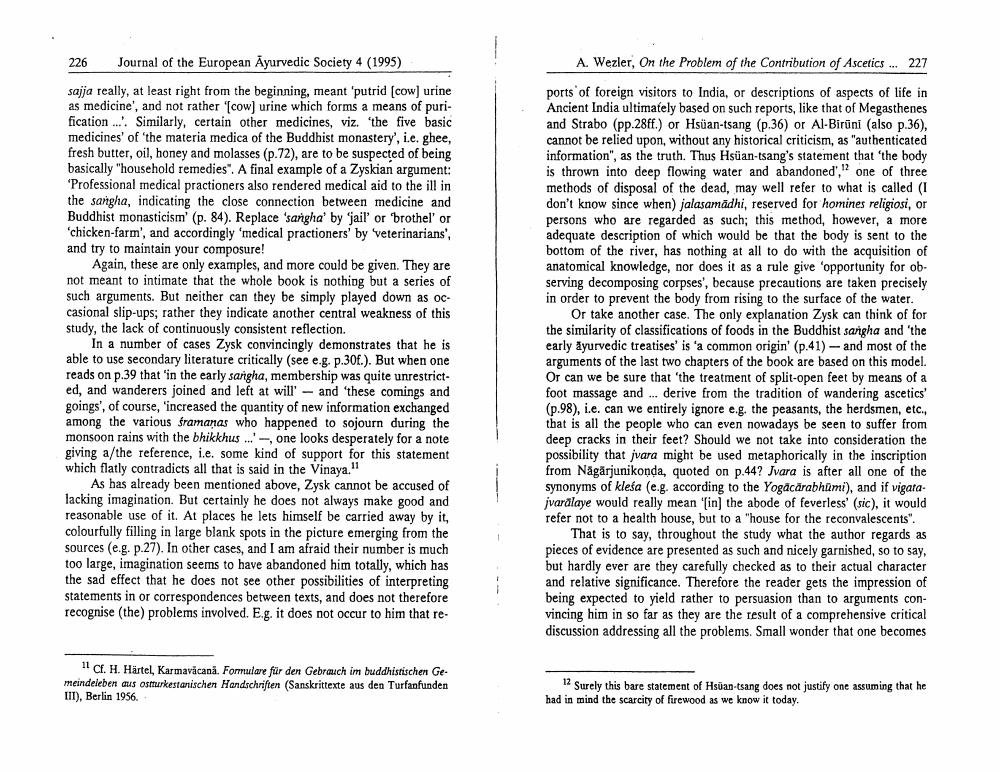________________
226
Journal of the European Ayurvedic Society 4 (1995)
A. Wezler, On the Problem of the Contribution of Ascetics ... 227
sajja really, at least right from the beginning, meant 'putrid (cow urine as medicine', and not rather "(cow) urine which forms a means of purification .... Similarly, certain other medicines, viz. 'the five basic medicines' of the materia medica of the Buddhist monastery', i.e. ghee, fresh butter, oil, honey and molasses (p.72), are to be suspected of being basically "household remedies". A final example of a Zyskian argument: 'Professional medical practioners also rendered medical aid to the ill in the sangha, indicating the close connection between medicine and Buddhist monasticism' (p. 84). Replace 'sangha' by jail' or 'brothel' or 'chicken-farm', and accordingly 'medical practioners' by veterinarians' and try to maintain your composure!
Again, these are only examples, and more could be given. They are not meant to intimate that the whole book is nothing but a series of such arguments. But neither can they be simply played down as occasional slip-ups; rather they indicate another central weakness of this study, the lack of continuously consistent reflection.
In a number of cases Zysk convincingly demonstrates that he is able to use secondary literature critically (see e.g.p.30.). But when one reads on p.39 that in the early sangha, membership was quite unrestricted, and wanderers joined and left at will' - and 'these comings and goings, of course, 'increased the quantity of new information exchanged among the various framanas who happened to sojourn during the monsoon rains with the bhikkhus ...'-one looks desperately for a note giving a/the reference, i.e. some kind of support for this statement which flatly contradicts all that is said in the Vinaya."
As has already been mentioned above, Zysk cannot be accused of lacking imagination. But certainly he does not always make good and reasonable use of it. At places he lets himself be carried away by it, colourfully filling in large blank spots in the picture emerging from the sources (e.g. p.27). In other cases, and I am afraid their number is much too large, imagination seems to have abandoned him totally, which has the sad effect that he does not see other possibilities of interpreting statements in or correspondences between texts, and does not therefore recognise (the) problems involved. Eg. it does not occur to him that re
ports of foreign visitors to India, or descriptions of aspects of life in Ancient India ultimately based on such reports, like that of Megasthenes and Strabo (pp.28ff.) or Hsüan-tsang (p.36) or Al-Birūni (also p.36), cannot be relied upon, without any historical criticism, as "authenticated information", as the truth. Thus Hsüan-tsang's statement that 'the body is thrown into deep flowing water and abandoned", one of three methods of disposal of the dead, may well refer to what is called (I don't know since when) jalasamadhi, reserved for homines religiosi, or persons who are regarded as such; this method, however, a more adequate description of which would be that the body is sent to the bottom of the river, has nothing at all to do with the acquisition of anatomical knowledge, nor does it as a rule give 'opportunity for observing decomposing corpses', because precautions are taken precisely in order to prevent the body from rising to the surface of the water.
Or take another case. The only explanation Zysk can think of for the similarity of classifications of foods in the Buddhist sangha and the early ayurvedic treatises' is 'a common origin' (p.41) - and most of the arguments of the last two chapters of the book are based on this model. Or can we be sure that 'the treatment of split-open feet by means of a foot massage and ... derive from the tradition of wandering ascetics' (p.98), i.e. can we entirely ignore e.g. the peasants, the herdsmen, etc., that is all the people who can even nowadays be seen to suffer from deep cracks in their feet? Should we not take into consideration the possibility that jvara might be used metaphorically in the inscription from Nagarjunikonda, quoted on p.44? Jvara is after all one of the synonyms of kleša (e.g. according to the Yogacarabhumi), and if vigatajvaralaye would really mean 'sin) the abode of feverless' (sic), it would refer not to a health house, but to a "house for the reconvalescents".
That is to say, throughout the study what the author regards as pieces of evidence are presented as such and nicely garnished, so to say, but hardly ever are they carefully checked as to their actual character and relative significance. Therefore the reader gets the impression of being expected to yield rather to persuasion than to arguments convincing him in so far as they are the result of a comprehensive critical discussion addressing all the problems. Small wonder that one becomes
1 Cf. H. Härtel, Karmavácanå. Formulare für den Gebrauch im buddhistischen Gemeindeleben aus Osturkestanischen Handschriften (Sanskrittexte aus den Turfanfunden LIT), Berlin 1956.
12 Surely this bare statement of Hsuan-tsang does not justify one assuming that he had in mind the scarcity of firewood as we know it today.




